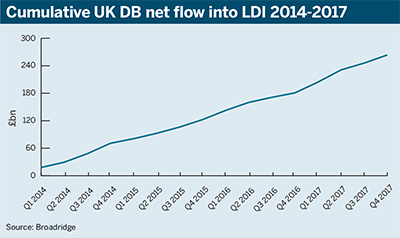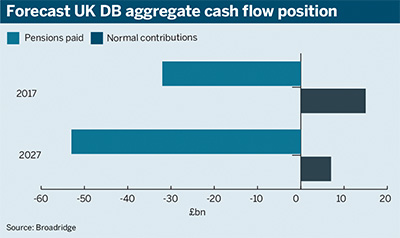Data Crunch: Broadridge's Jonathan Libre takes a look at the evolution of defined benefit investment strategies to date, and outlines potential new trends as final salary plans mature.
This has resulted in the emergence of a multitude of different approaches that differ according to the outcome that the scheme is trying to achieve, and the challenges the scheme is trying to address.
One of the first of these challenges to be considered was investment risk: how could a scheme achieve the returns needed to close funding deficits without having to ride through the volatility associated with high allocations to equity?
With the DB market expected to turn increasingly cash flow negative over the next 10 years, cash flow-driven investment solutions have attracted attention
Within this context, diversified growth funds built on a mantra of ‘equity-like returns with lower volatility’ proved extremely popular.
While DGFs covered the numerator of the funding ratio equation, liability-driven investment has allowed schemes to consider the denominator.
With liability valuations rocketing in the low interest rate environment, schemes increasingly turned to LDI as a means of stabilising their funding ratios.
By 2017, according to the annual XPS Pensions survey, 49 per cent of DB liabilities were hedged using LDI mandates. In our own data, we saw £264bn move into LDI strategies between 2014 and 2017.
End-game oriented solutions now coming to the fore
More recently, outcome-oriented solutions have evolved to focus more heavily on the end game. With the DB market expected to turn increasingly cash flow negative over the next 10 years, cash flow-driven investment solutions have attracted attention.
CDI moves beyond the asset-liability valuation matching paradigm, and also considers the schemes’ income needs. With assets managed on a ‘buy and maintain’ basis, sequencing risk (the risk that a scheme has to sell assets in a market downturn to pay pensioners and therefore crystallise investment losses) can be mitigated.
For schemes looking to go one step further, and also hedge longevity risk, providers are also coming to market with synthetic buyout approaches comprising a CDI portfolio with longevity swaps.
Scoping out the insurance market
An increasing proportion of schemes are targeting buyout, but it must be remembered that the insurance market’s capacity to absorb DB liabilities through bulk annuities is limited; the total value of buyout deals completed in the four years to the end of 2017 amounted to just £15bn.
Solutions are now emerging to help schemes adjust their investment portfolios to make the eventual buyout transaction easier.
Some adjustments are subtle, such as moving from a gilts to swaps basis within their LDI portfolios to match insurers.
Other approaches have gone so far as to develop portfolio solutions that allow schemes to eventually transact with an insurer through an in-specie transfer of assets with no transaction costs.
Despite this broad range of different approaches addressing different outcomes and challenges, trustees should always expect these solutions to have been built across two distinct phases.
Firstly, there is the need to identify the desired outcome and measure the scale of the challenge that needs to be addressed.
Once this has been completed, providers can design and implement a solution that will best meet the schemes’ requirements.
Jonathan Libre is principal in the EMEA Insights team at Broadridge Financial Solutions














